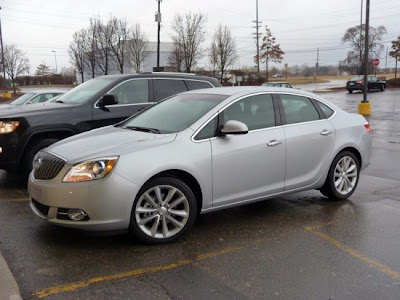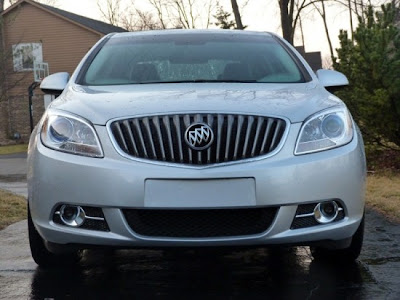 |
| Verano rear quarter > Sport Car Buick Verano Take Two |
Buick Verano Take Two Sport Car : external appearance stylishly, sporty and charming Mobil's Buick Verano Sport Car, with the style and the latest technologies Cars Buick Verano appear to answer the future, you're curious to see the detail Sporty Cars Buick Verano ?
 |
| Verano side > Sport Car Buick Verano Take Two |
What is a Buick? Having saved the brand, GM must now figure out what to do with it. Traditionally Buick occupied the middle ground between Chevrolet and Cadillac, originally closer to the latter but from the 1970s onwards dangerously close to the former, which had expanded upwards in lockstep with archrival Ford. Aesthetically, Buicks have been the yin to Cadillac’s yang, curvier, less aggressive, and potentially more appealing to women. (Or metrosexuals? Did women ever drive a significant number of Rivs and Park Avenues?) Logically, there ought to be a position within this position for a compact car. Some people want a softly styled, upscale car, but don’t need a large car. But successfully fielding a car in this position has been tricky. The Lexus HS finds only a couple hundred takers each month. Jaguar abandoned the segment a few years ago, and Volvo quit it more recently. So does the Buick Verano stand a chance?
 |
| Verano front quarter > Sport Car Buick Verano Take Two |
A car needn’t be beautiful to sell—but it doesn’t hurt. Based on spy shots of prototypes I expected the Verano to be downright ugly, with an overly raked windshield and its requisite windowlettes throwing off the proportions. But in production form, with appropriately styled 18-inch alloy wheels (GM has for once made the right size wheel the only size), the Verano is a handsome car. No Jaguar, but certainly more attractive than the HS and more upscale than the Chevrolet Cruze (with which it shares a platform). But it’s not the strikingly attractive car it could have been. Will many people notice the compact Buick on the street? Will any of them have a “gotta have it” reaction? One thing is certain: the Verano won’t step on the Cadillac ATS’s toes.
 |
| Verano front > Sport Car Buick Verano Take Two |
The Verano’s interior isn’t as nice as that of the Lexus, but is a half-step up from that of the Chevrolet Cruze. You’ll find no cheap bits, yet the sense lingers that this isn’t quite a premium car. While intelligent design stylishly inserts a soft-touch face into the hard plastic instrument panel, the overly hard, overly thin door pulls seem pedestrian. The seats, though comfortable and supportive, lack power recline. Even compact Mazdas and Suzukis—hardly makes known for luxury—offer this feature. Can a car be “premium” without it? Rear seat legroom is marginal for adults, though ample space for feet beneath the front seats helps. A non sequitur: the steering wheel is too thick, which could turn off many potential female buyers.
Luxury car buyers don’t typically make runs for the redline. But this is entirely the point: they don’t want to feel the need to go anywhere near the redline. Instead, they want a car’s acceleration to feel effortless and for its engine to be felt but not heard. The Verano’s 180-horsepower 2.4-liter engine is stronger than the Cruze’s 138-horsepower 1.4 turbo, but it’s also naturally aspirated with a high (4,900 rpm) torque peak. To move 3,300 pounds of compact Buick, the fourhas to rev. It’s willing and able to do this, and with a modicum of refinement, but like the styling the engine isn’t going to inspire people to reach for their checkbooks. GM plans to also offer the Verano with a 250-horsepower 2.0-liter turbo, and this engine should be a better fit for the car’s mission.
 |
| Verano interior > Sport Car Buick Verano Take Two |
Economy
So far we have nothing making Buick’s new compact sedan a “must have,” but also nothing that’s likely fatal. But then, as Ed Niedermeyer pointed out in his thorough evaluation of the Verano, there’s fuel economy. EPA ratings of 22 city and 31 highway don’t even compare well to four-cylinder midsize cars, much less other compacts. In suburban driving, the trip computer usually reported between 20 and 25, with high 20s happening only with favorable traffic signals and a feather-light right foot. Even the two-ton, 240-horsepower, all-wheel-drive 528i does a bit better (in my real-world testing as well as on the window sticker). Of course, the Lexus HS has sold poorly despite 35/34 ratings, so fuel economy isn’t everything.
The biggest surprise here is how the Verano rides and handles. It’s more tightly damped than a Chevrolet Cruze, with nary a hint of the float that once typified Buicks. Yet the car’s ride is still comfortable, with admirable composure over rough pavement. You’ll feel and hear the bumps and divots, but not overly much (this is a VERY quiet car), and they’re quickly dispatched. Hard cornering flushes out moderate amounts of body roll and front tire scrub, but overall the car is well controlled. The largest killjoys are visibility-impeding A-pillars and numb steering. Fix the last, and they’d about have the chassis where it needs to be—if people can get their heads around the idea of an athletic Buick. (Lexus can’t seem to overcome a similar perceptual challenge.)
 |
| Verano engine > Sport Car Buick Verano Take Two |
Pricing
Some good stuff so far, but nothing outstanding. Sow how is the compact Buick outselling the compact Lexus by nearly an order of magnitude (2,497 in March)? Pricing. A leather-upholstered Verano like the one tested lists for $26,850. For a sunroof add $900, for nav $795. Not cheap, surely. After adjusting for feature differences (with TrueDelta’s car price comparison tool) the compact Buick checks in about $2,000 above a Cruze or Focus. But this leaves it about $5,000 below an Acura TSX and nearly $12,000 below a Lexus HS 250h (details). Even if we allow a generous $4,000 for the HS’s hybrid bits, the reason for the car’s slow sales becomes clear.
The midsize Buick Regal is about $3,000 more. Notably, its sales in March were down about 1,000 from a year ago. The suffering will increase once the Verano is available with a more powerful engine (assuming reasonable pricing). The new car’s sales suddenly seem less impressive.
The Buick Verano, like the larger Regal, is positioned a quarter-step above the related Chevrolet. A little more style, slightly upgraded materials, a smattering of additional features, moderately firmer suspension tuning, a two-grand bump on the window sticker. A pleasant car, even surprisingly so in some areas (quietness, suspension tuning), but not an outstanding one. Not enough of an upgrade to directly compete with Acura, Lexus, and the Europeans, but not priced to directly compete with them, either. The upside: no direct competitors. The downside: no direct competitors—potential buyers might have trouble categorizing the cars. In appearance, content, and pricing the Verano (like other Buicks) is much closer to the related Chevrolet than to its alleged competitors. While this minimized the effort required to create it, GM should do what it takes to split the difference more evenly.
Description: Review : Sport Car Buick Verano Take Two
Rating: 3.5
Reviewer: Eman
ItemReviewed: Review : Sport Car Buick Verano Take Two




